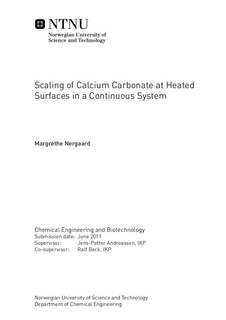Scaling of Calcium Carbonate at Heated Surfaces in a Continuous System
Master thesis
Permanent lenke
http://hdl.handle.net/11250/248354Utgivelsesdato
2011Metadata
Vis full innførselSamlinger
Sammendrag
Scaling is the precipitation of a mineral layer on a surface. Sparingly soluble salts with inverse solubility, which calcium carbonate exhibits, will prefer precipitation at heated surfaces, making heat exchangers a target for scale formation. A continuous setup was used to study scale formation, the nature of the scale formed and scaling rate. An internally heated U-shaped tube was inserted into a continuously stirred tank, giving the same conditions for all scaling points. The experimental setup allowed the supersaturation to be constant throughout the experiment. An onset of scale formation was found around Scalcite~4.5 for a tube surface temperature of 90°C. The surface was first covered with an introductory scale layer before outward directed dendritic growth took place. The deposited mass increased by 35% when the temperature of the heated tube was increased from 50°C to 90°C. At tube temperature 50°C, 43% calcite and 56% aragonite was formed. As temperature was increased to 70°C and above, more than 97% of the scale layer was aragonite. Less vaterite than predicted by literature was found. Increasing the supersaturation increased the amount of scale formed. A linear relationship between supersaturation and deposited mass was identified. However, this is not expected to be valid for all ranges of supersaturations due to the correlation between growth mechanisms and supersaturation. Increasing the bulk temperature when the tube temperature was constant had little impact on the deposited mass, but changed the morphology towards a more porous and fragile structure. Extensive bulk nucleation occurred at high supersaturations. The effective steady state supersaturation in close vicinity to the heated surface was reduced from the initial by almost 130% for the high supersaturation, compared to 35% for the lower. This points towards a threshold in supersaturation; above this, bulk nucleation will consume most of the excessive supersaturation introduced to the system. Scale growth rate for aragonite at high supersaturation (S=20) was experimentally determined to the range of 1.2E-5 and 1.6E-5 kg/m2s. For the lower supersaturation (S=6), a constant scale growth rate of 3.5E-6 kg/m2s was found. By assuming a density of the scale layer, linear growth rates of ~22 nm/s and 5 nm/s for S=20 and S=6 respectively, were obtained. These were compared to linear growth rates of aragonite from batch experiments. The morphology and polymorphism of the scale being was investigated by Scanning electron microscope (SEM) and powder X-ray diffraction (XRD), respectively.
